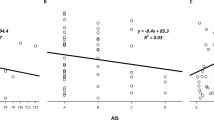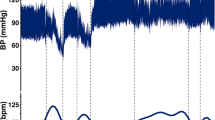Abstract
Study design:
Review.
Objectives:
Identify and describe the body of literature pertaining to non-pharmacological management of orthostatic hypotension (OH) during the early rehabilitation of persons with a spinal cord injury (SCI).
Setting:
Sunnaas Rehabilitation Hospital, Oslo, Norway.
Methods:
Search strategy: a comprehensive search of electronic databases and cited references was undertaken. Selection criteria: case studies, parallel group trials and crossover designs using random or quasi-random assignments were considered. Participants with any level or degree of completeness of SCI and any time elapsed since injury were included. Interventions must have measured at least systolic blood pressure (BP), and have induced orthostatic stress in a controlled manner and have attempted to control OH during an orthostatic challenge. Data collection and analysis: studies were selected, assessed and described qualitatively. Meta-analysis was deemed inappropriate.
Results:
Four distinct non-pharmacological interventions for OH were identified: application of compression and pressure to the abdominal region and/or legs, upper body exercise, functional electrical stimulation (FES) applied to the legs and biofeedback. Methodological quality varied dramatically between studies. Compression/pressure, upper body exercise and biofeedback therapies have proven inconclusive in their ability to control OH. During orthostatic challenge, FES consistently attenuates the fall in BP; however, its clinical application is less well established.
Conclusions:
The clinical usefulness of compression/pressure, upper body exercise and biofeedback for treating OH has not been proven. FES of the legs holds the most promise.
Similar content being viewed by others
Log in or create a free account to read this content
Gain free access to this article, as well as selected content from this journal and more on nature.com
or
References
Sidorov EV, Townson AF, Dvorak MF, Kwon BK, Steves J, Krassioukov A . Orthostatic hypotension in the first month following spinal cord injury. Spinal Cord 2007; 46: 65–69.
Illman I, Stiller K, Williams M . The prevalence of orthostatic hypotension during physiotherapy treatment in patients with an acute spinal cord injury. Spinal Cord 2000; 38: 741–747.
Consensus committee of the American Autonomic Society and American Academy of Neurology. Consensus statement on the definition of orthostatic hypotension, pure autonomic failure and multiplesystems atrophy. Neurology 1996; 46: 1470.
Claydon VE, Steeves JD, Krassioukov A . Orthostatic hypotension following spinal cord injury: understanding clinical pathophysiology. Spinal Cord 2006; 44: 341–351.
Cariga P, Ahmed S, Mathias CJ, Gardner BP . The prevalence and association of neck (coat-hanger) pain and orthostatic (postural) hypotension in human spinal cord injury. Spinal Cord 2002; 40: 77–82.
Lopes P, Figoni SF, Perkash I . Upper limb exercise effect on tilt tolerance during orthostatic training of patients with spinal cord injury. (electronic version). Arch Phys Med Rehabil 1984; 65: 251–253.
Faghri PD, Yount JP, Pesce WJ, Seetharama S, Votto JJ . Circulatory hypokinesis and functional electric stimulation during standing in persons with spinal cord injury. (electronic version). Arch Phys Med Rehabil 2001; 82: 1587–1595.
Chao CY, Cheing GL . The effects of lower-extremity functional electric stimulation on the orthostatic responses of people with tetraplegia. [electronic version]. Arch Phys Med Rehabil 2005; 86: 1427–1433.
Davis GM, Climstein M, Kelleher P, Lukban F, Sutton JR . Cardiac performance during tilting and ES induced leg muscle contractions in paraplegics. Med Sci Sports Exerc 1993; 25: S104.
Elokda AS, Nielsen DH, Shields RK . Effect of functional neuromuscular stimulation on postural related orthostatic stress in individuals with acute spinal cord injury. (electronic version). J Rehabil Res Dev 2000; 37: 535–542.
Raymond J, Davis GM, Bryant G, Clarke J . Cardiovascular responses to an orthostatic challenge and electrical-stimulation-induced leg muscle contractions in individuals with paraplegia. Eur J Appl Physiol 1999; 80: 205–212.
Sampson EE, Burnham RS, Andrews BJ . Functional electrical stimulation effect on orthostatic hypotension after spinal cord injury. (electronic version). Arch Phys Med Rehabil 2000; 81: 139–143.
Huang CT, Kuhlemeri KV, Ratanaubol U . Cardiopulmonary response in spinal cord injury patients: effect of pneumatic compression devices. Arch Phys Med Rehabil 1983; 64: 101–106.
Krassioukov AV, Harkema SJ . Effect of harness application and postural changes on cardiovascular parameters of individuals with spinal cord injury. (electronic version). Spinal Cord 2006; 44: 780–786.
Vallbona C, Spencer WA, Cardus D, Dale JW . Control of orthostatic hypotension of quadriplegic patients with pressure suits. Arch Phys Med Rehabil 1963; 44: 7–18.
Engelke KA, Shea JD, Doerr DF, Convertino VA . Enhanced carotid-cardiac baroreflex response and elimination of orthostatic hypotension 24 h after acute exercise in paraplegics. (electronic version). Paraplegia 1992; 30: 872–879.
Brucker BS, Ince LP . Biofeedback as an experimental treatment for postural hypotension in a patient with a spinal cord lesion. (electronic version). Arch Phys Med Rehabil 1977; 58: 49–53.
Ince LP . Biofeedback as a treatment for postural hypotension. Psychosom Med 1985; 47: 182–188.
Downs SH, Black N . The feasibility of creating a checklist for the assessment of the methodological quality both of randomized and non-randomized studies of health care interventions. J Epidemiol Community Health 1998; 52: 377–384.
Engelke KA, Shea JD, Doerr DF, Convertino VA . Autonomic functions and orthostatic responses 24 h after acute intense exercise in paraplegic subjects. [Electronic version]. Am J Physiol 1994; 266 (4 Pt 2): R1189–R1196.
Faghri PD, Yount J . Electrically induced and voluntary activation of physiologic muscle pump: a comparison between spinal cord-injured and able-bodied individuals. (electronic version). Clin Rehabil 2002; 16: 878–885.
Ragnarsson KT, Sell HG, McGarrity M, Ofir R . Pneumatic orthosis for paraplegic patients: functional evaluation and prescription considerations. Arch Phys Med Rehabil 1975; 56: 479–483.
Hopman MT, Monroe M, Dueck C, Phillips WT, Skinner JS . Blood redistribution and circulatory responses to submaximal arm exercise in persons with spinal cord injury. Scan J Rehabil Med 1998; 30: 167–174.
Pitetti KH, Barrett PJ, Campbell KD, Malzaen DE . The effect of lower body positive pressure on the exercise capacity of individuals with spinal cord injury. Med Sci Sports Exerc 1994; 26: 463–468.
McCluer S . A temporary method of controlling orthostatic hypotension in quadriplegia. Arch Phys Med Rehabil 1968; 49: 598–599.
Jones RF, Burniston GG . A strapless pneumatic belt for the control of orthostatic hypotension in quadriplegia. (electronic version). Med J Aust 1969; 1: 1136–1137.
Goldman JM, Rose LS, Wiliams SJ, Silver JR, Denison DM . Effect of abdominal binders on breathing in tetraplegic patients. Thorax 1988; 41: 940–945.
Kerk JK, Clifford PS, Snyder AC, Prieto TE, O'Hagan KP, Schot PK et al. Myklebust effect of an abdominal binder during wheelchair exercise. Med Sci Sports Exerc 1995; 27: 913–919.
Johnson RH, Crampton A, Smith AC, Spalding JMK . Blood pressure response to standing and Valsalva's manoeuvre: independence of two mechanisms in neurological diseases including cervical cord leasions. Clin Sci 1969; 36: 77–86.
Petrofsky JS . Blood pressure and HR response to isometric exercise: The effect of spinal cord injury in humans. (electronic version). Eur J Appl Physiol 2001; 85: 521–526.
Krassioukov AV, Karlsson AK, Wect JM, Wuermser LA, Matthias CJ, Marino RJ . Assessment of autonomic dysfunction following spinal cord injury: rational for additions to International Standards for Neurological Assessment. J Rehabil Res Dev 2007; 44: 103–112.
Acknowledgements
This project was funded under a full scholarship provided by Erasmus Mundus Master in Adapted Physical Activity Program. This program in turn receives funding from The European Commission. The authors graciously thank Dr Andre Krassioukov of the Department of Physical Medicine and Rehabilitation, University of British Columbia, Vancouver, Canada, for providing his invaluable critique during the development of the manuscripts.
Author information
Authors and Affiliations
Corresponding author
Rights and permissions
About this article
Cite this article
Gillis, D., Wouda, M. & Hjeltnes, N. Non-pharmacological management of orthostatic hypotension after spinal cord injury: a critical review of the literature. Spinal Cord 46, 652–659 (2008). https://doi.org/10.1038/sc.2008.48
Received:
Revised:
Accepted:
Published:
Issue date:
DOI: https://doi.org/10.1038/sc.2008.48
Keywords
This article is cited by
-
Spinal Cord Stimulation After Spinal Cord Injury: Promising Multisystem Effects
Current Physical Medicine and Rehabilitation Reports (2021)
-
Autonomic Neuropathy and Cardiovascular Disease in Aging
The Journal of nutrition, health and aging (2018)
-
Abdominal binder use in people with spinal cord injuries: a systematic review and meta-analysis
Spinal Cord (2009)



